不锈钢完整指南
不锈钢牌号、成分、分子结构、生产和性能
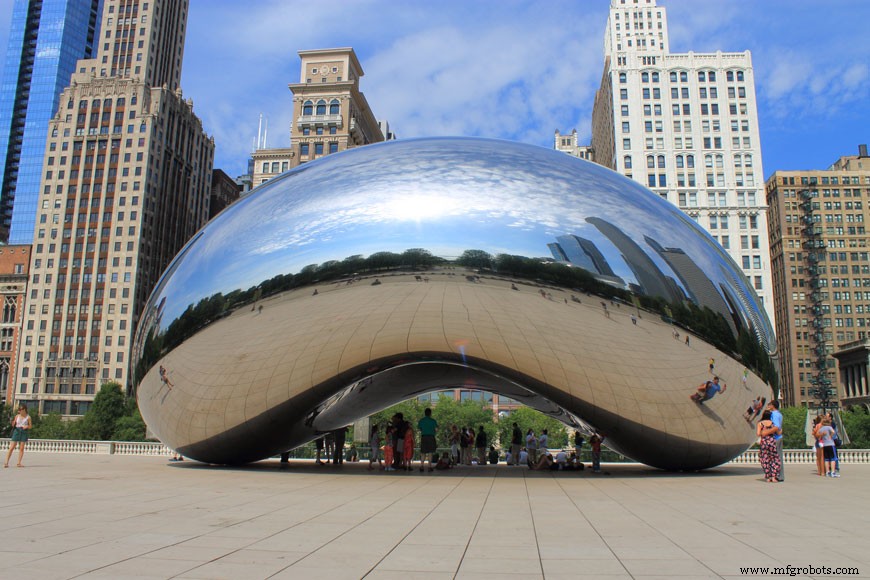
在本指南中:
- 不锈钢是如何制成的?
- 不锈钢是由什么制成的?
- 不锈钢的种类
- 不锈钢牌号
- 不锈钢有磁性吗?
- 不锈钢的机械性能
- 技术外观 - 不锈钢的分子微观结构
- 保养和维护
不锈钢是一大类防锈铁合金的通用名称。与其他铁合金不同,不锈钢具有稳定的钝化层,可保护其免受空气和湿气的影响。这种防锈性使其成为许多应用的理想选择,包括户外、水、食品服务和高温用途。
不锈钢是如何制成的?
不锈钢可以铸造或锻造。主要区别在于它是如何形成最终产品的。 铸造不锈钢 是通过将液态金属倒入具有特定形状的成型容器中制成的。 锻造不锈钢 从钢厂开始,连铸机将不锈钢制成钢锭、大方坯、方坯或板坯。然后必须通过进一步的工作来塑造这些原材料。它们使用滚压或锤击技术重新加热和返工。
锻造不锈钢产品比铸造不锈钢产品更常见。
铸造不锈钢物体通常在铸造厂或在铸造厂的监督下制造和完成。如果它们是较大产品的一小部分,则铸件可能会去其他工厂进行组装。锻造不锈钢始于钢厂,但在另一家工厂加工成最终产品。
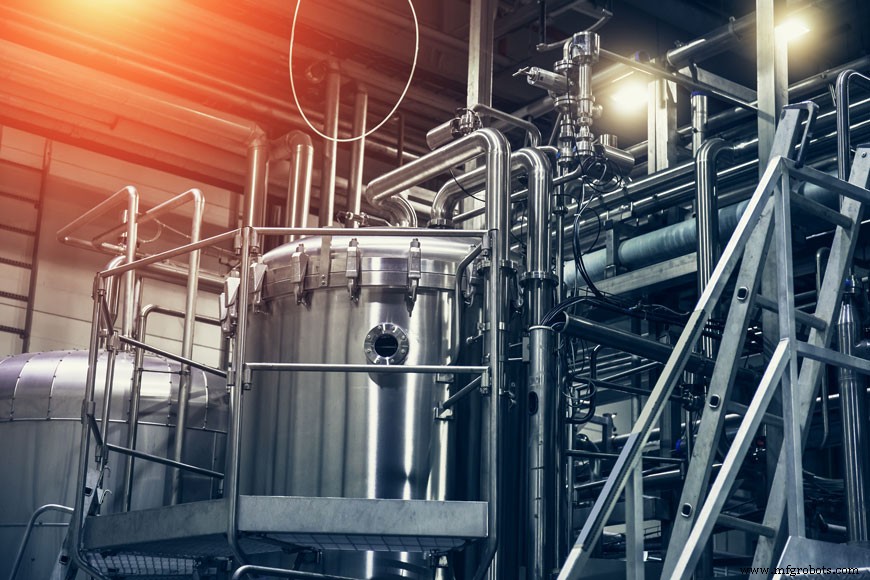
不锈钢是由什么制成的?
像所有钢一样,不锈钢从铁和碳的混合物开始。使这个合金系列与众不同的是不锈钢还含有至少 10.5% 的铬。这种元素使不锈钢具有抗氧化的特性。当不锈钢暴露在大气中时,铬与氧结合形成一层薄而稳定的氧化铬 (III) (Cr2O3) 钝化层。钝化层保护内部钢不被氧化,如果表面被划伤,很快就会重新形成。
该钝化层不同于电镀。一些金属镀有锌、铬或镍,用于表面保护。在这些情况下,一旦划痕穿透镀层,涂层的好处就会丧失。不锈钢内部的铬提供的不仅仅是这种表面保护。每当它暴露在空气中时,它就会产生它的钝化膜。因此,即使不锈钢被深度划伤,钝化层也会自愈。
铁 + 碳 =钢
+ 铬 =不锈钢
(至少 10.5% 铬)
铁素体合金
铬
(10.5–18%)
碳
(0.08–0.15%)
铁素体合金
铬 (10.5–18%)
碳 (0.08–0.15%)
马氏体合金
碳
(0.10–1.2%)
+ 铬
(12-18%)
生产可能涉及淬火或空气硬化。
马氏体合金
碳 (0.10–1.2%)
+ 铬 (12-18%)
生产可能涉及淬火或空气硬化。
奥氏体合金
+ 铬
(16%)
+ 镍
(8+%)
可能含有钼、钛或铜。
奥氏体合金
+ 铬 (16%)
+ 镍 (8+%)
可能含有钼、钛或铜。
双相合金
+ 铬 (19+%)
+ 钼
+少量镍
一般含有钼、铜或其他合金元素。
双相合金
+ 铬 (19+%)
+ 钼
+少量镍
一般含有钼、铜或其他合金元素。
沉淀硬化合金
+ 铬
+ 镍
+ 铜和/或其他元素
生产必须涉及热处理技术。
沉淀硬化合金
+ 铬
+ 镍
+ 铜和/或其他元素
生产必须涉及热处理技术。
不锈钢的种类
不锈钢有几个“家族”。这些家族中的每一个都具有不同比例的铁、铬和碳。有些含有其他元素,如镍、钼、锰或铜。这些钢的性能因含量而异,使其成为一种用途广泛的合金。
不锈钢牌号
等级暗示了特定不锈钢的家族。最常见的等级是:
- 铁素体不锈钢:430、444、409
- 奥氏体不锈钢:304、302、303、310、316、317、321、347
- 马氏体不锈钢:420、431、440、416
- 双相不锈钢:2304、2205
有时,工程师会在同一系列的合金之间进行选择,例如两种流行的商业级奥氏体不锈钢,304 与 316。然而,情况并非总是如此。汽车排气系统通常在 304 和 409 之间进行选择。烧烤烤架可能由 304 或 430 制成。
不锈钢有磁性吗?
用磁铁来确定你面前的金属是否是不锈钢的,并不能给你一个明确的答案。有些等级和类型的不锈钢具有磁性,有些则没有——这完全取决于合金中的不同元素。
奥氏体不锈钢等级的钢(3xx 系列)没有磁性。您的不锈钢冰箱没有磁铁和冰箱艺术品?奥氏体不锈钢由于晶体的微观结构。 (在我们的技术部分阅读更多内容。)
马氏体和更常见的铁素体不锈钢等级,如 430,具有磁性。双相钢是奥氏体钢和铁素体钢的混合物,通常具有轻微的磁性。铁素体钢上的磁铁可以牢牢固定住。仍然在双工上,可能更容易中断和滑落。
不锈钢的机械性能
通常选择不锈钢是因为它耐腐蚀,但也选择它是因为它是钢。强度、屈服、韧性、硬度、对加工硬化的反应、可焊性和耐热性等特性使钢在工程、建筑和制造中成为一种非常有用的金属,尤其是考虑到它的成本。工程师在决定不锈钢等级之前考虑了不锈钢的工作负荷和大气条件。
拉伸性能
金属的拉伸性能是通过拉力来测量的。一根有代表性的拉力杆承受拉力,也称为拉力载荷。失效后,测量其抗拉强度、屈服强度、伸长率和断面收缩率。
硬度
硬度是钢抵抗压痕和磨损的能力。两种最常见的硬度测试是布氏硬度测试和洛氏硬度测试。在布氏试验中,将一个小的硬化钢球通过标准载荷压入钢中,并测量所得压痕的直径。洛氏测试测量压痕的深度。通过冷加工(也称为加工硬化)可以增加某些金属的硬度。在某些金属中,可以通过热处理提高硬度。
韧性
韧性是钢在非常局部的应力下塑性屈服的能力。坚韧的钢具有抗开裂的能力,使韧性成为工程应用中非常理想的品质。韧性水平使用动态测试来确定。样品棒被刻痕以定位应力,然后被摆动的钟摆撞击。破坏样品棒时吸收的能量是通过摆锤损失的能量来衡量的。坚硬的金属吸收更多的能量,而脆性金属吸收的能量更少。
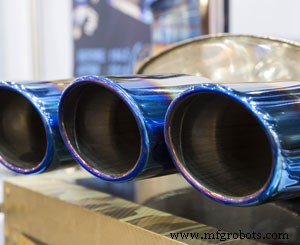
铁素体
铁素体不锈钢含有铁、碳和 10.5–18% 的铬。它们可能含有其他合金元素,例如钼或铝,但通常含量非常少。它们具有体心立方 (BCC) 晶体结构——在环境温度下与纯铁相同。
由于其晶体结构,铁素体不锈钢具有磁性。它们相对较低的碳含量会产生相应的低强度。铁素体类型的其他弱点包括可焊性差和耐腐蚀性降低。然而,由于其卓越的韧性,它们对于工程应用来说是理想的。铁素体不锈钢通常用于汽车排气管、燃油管路和建筑装饰。
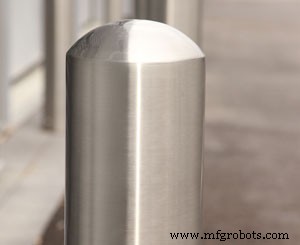
奥氏体
奥氏体不锈钢具有面心立方 (FCC) 晶体结构,由铁、碳、铬和至少 8% 的镍组成。由于它们的高铬和镍含量,它们具有高度的耐腐蚀性和非磁性。与铁素体不锈钢一样,奥氏体不锈钢不能通过热处理硬化。然而,它们可以通过冷加工硬化。奥氏体不锈钢中的高镍含量使其能够在低温应用中发挥良好的作用。
两种最常见的不锈钢——304 和 316——都是奥氏体不锈钢。奥氏体不锈钢普及的主要驱动力是它们易于成型和焊接,使其成为高效制造的理想选择。奥氏体不锈钢有许多亚组,其碳含量差异很大。通过添加钼、钛和铜等合金元素,进一步调整了这些特性。奥氏体不锈钢经常用于生产厨房水槽、窗框、食品加工设备和化学罐。它们也常用于户外场地陈设,如长凳、不锈钢护柱和自行车架。
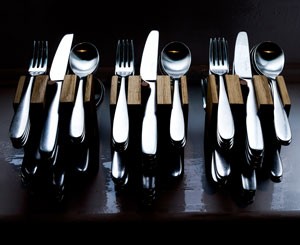
马氏体
马氏体不锈钢具有体心四方 (BCT) 结构。它们含有 12–18% 的铬,并且比奥氏体或铁素体不锈钢具有更高的碳含量 (0.1–1.2%)。与铁素体 BCC 结构一样,BCT 具有磁性。马氏体不锈钢在钢的强度比其可焊性或耐腐蚀性更重要的情况下非常有用。主要区别在于马氏体不锈钢可以通过热处理硬化,因为它们的碳含量高。这使得它们可用于许多应用,包括航空零件、餐具和刀片。
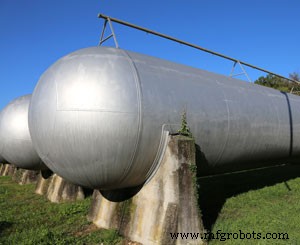
双工
双相不锈钢是最新的不锈钢类型。与奥氏体不锈钢相比,它们含有更多的铬(19-32%)和钼(高达 5%),但镍含量明显减少。双相不锈钢有时被称为奥氏体-铁素体,因为它们具有混合的铁素体和奥氏体晶体结构。双相不锈钢中奥氏体相和铁素体相的大约一半混合赋予了它独特的优势。它们比奥氏体等级更耐应力腐蚀开裂,比铁素体等级更坚韧,并且比两者的纯形式强大约两倍。双相不锈钢的主要优点是在氯化物暴露情况下的耐腐蚀性等于或超过奥氏体不锈钢。
双相不锈钢也非常具有成本效益。双相不锈钢的强度和耐腐蚀性是通过比同等奥氏体等级更低的合金含量实现的。双相不锈钢经常用于生产脱盐和石化行业中暴露于氯化物应用的零件。它们还用于桥梁、压力容器和拉杆的建筑和施工行业。
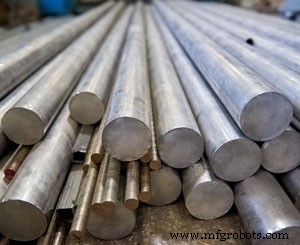
沉淀硬化
沉淀硬化不锈钢可以具有一系列晶体结构,但是它们都含有铬和镍。它们的共同特点是耐腐蚀、易于加工、低温热处理后具有极高的抗拉强度。
奥氏体沉淀硬化合金大多已被更高强度的高温合金所取代。然而,半奥氏体沉淀硬化不锈钢继续用于航空航天应用,甚至应用于新形式。马氏体沉淀硬化不锈钢比普通马氏体不锈钢强度更高,经常用于生产棒材、棒材和线材。
技术外观:不锈钢的分子微观结构
当金属从熔融状态冻结出来时,它们会结晶并形成晶粒。这种晶体结构决定了金属的许多机械性能。影响这种微观结构的因素很多。
由于这些原子类型形成的分子,合金中的原子类型会改变结构。每种材料的百分比也决定了原子的排列方式。
温度对金属晶格的形状有着深远的影响。在特定温度下开始形成不同的结构。合金有相表,可以显示在不同温度下常见的晶粒类型以及重要元素的不同百分比。
我们的铁碳相图说明了温度和碳对钢中晶粒形成的影响方式。它显示了铁形成的三个阶段:
- 铁素体或 α 铁 (α) 是在低于 912°C 的温度下形成的标准晶粒。
- 奥氏体或伽马铁 (γ) 具有更密集的晶粒晶体,并出现在 912-1394°C 之间。
- 三角铁 (δ) 在 1395°C 以上的温度下形成,然后铁在 1538°C 变成液体。 δ 铁相更接近于 α-铁或铁素体。
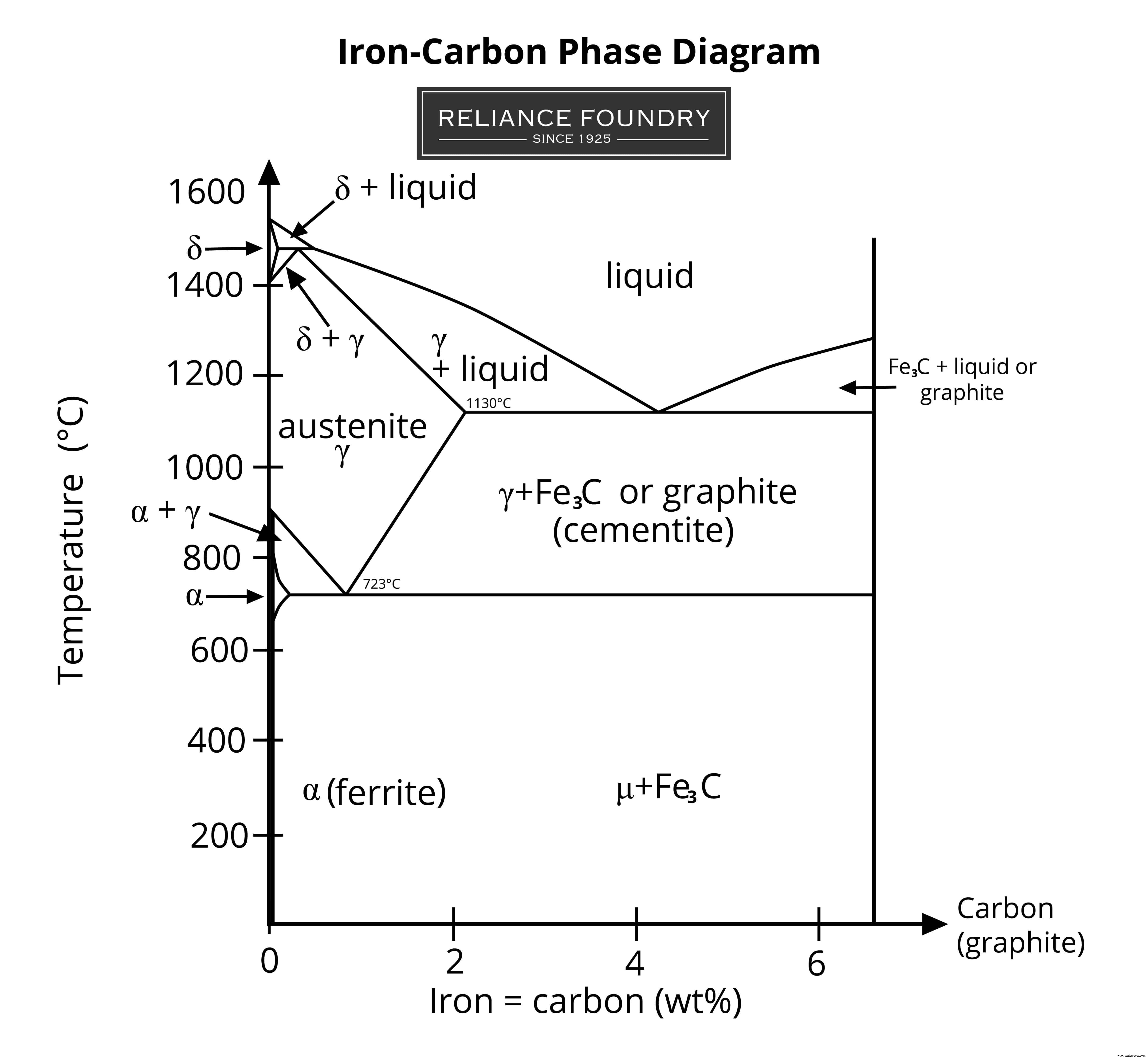
添加碳会影响钢的基本晶粒如何结晶、稳定和相互作用。温度会影响碳的吸收方式。高温奥氏体相被碳饱和,金属分子密集。在其他温度下,所有的碳都没有被吸收。它创造了其他分子结构。例如,铁碳合金通常含有 Fe3C 渗碳体分子。在纯粹的形式中,渗碳体被归类为陶瓷:它又硬又脆,并将这些属性赋予最终金属。石墨也可以在分子水平上形成。这种石墨的形状会影响金属在撞击时的行为。圆形石墨结节在受到撞击时可以相互滑过,变形但不会折断。相比之下,具有大量片状石墨的金属在受到撞击时会沿着片状边界发生剪切。金属冷却的速度,以及是否经过热处理或加工,也会影响晶粒尺寸和形状。
奥氏体钢是具有带有γ-铁的奥氏体晶格的钢。在铁碳相图上,这种晶格通常出现在高温下。然而,添加镍和/或锰可使奥氏体在钢冷却时保留下来。奥氏体微观结构被称为“面心立方”。面心立方分子赋予金属特殊的性质。
体心与面心立方微结构
金属是由分子晶格构成的晶体。晶格的每个单元都是由原子组成的。每个晶格单元中的原子数量以及它们如何相互连接,会改变该晶格在应变下的行为方式。基本格是原始的、以体为中心的、以面为中心的。
基本细胞形状
原始
立方

- 这个原始立方体中的每个原子都位于单元格的一个角落。每个原子都是晶格中的一个连接点。
- 每个角原子都与其周围的细胞平等地共享。因此,每个原子都是八个相邻立方体的一部分。
- 晶胞总共包含 1 个原子。因为每个角原子都与八个相邻的立方体共享,所以每个原子只有 1/8 在原始单元内。
每个角原子的 8 x 1/8 片 =总共 1 个原子。
身体-
居中
立方 (BCC)

- 与原始立方形式一样,细胞的每个角落都有原子。
- 此外,一个原子位于单元格的中间。这个原子不被其他单元共享:有 8 个单元连接到晶格,一个单元只连接到原子。
- 晶胞总共包含 2 个原子:
每个原子有 8 个原子 x 1/8 份额,如在原始立方结构中,加上中心的原子。 - α-铁(铁素体)和 δ-铁都是 BCC 金属。
以面为中心
立方 (FCC)

- 面心立方结构在晶胞的每个角落都有原子,在立方体每个面的中心还有一个原子。
- 以“面”为中心的原子仅由两个单元共享,因此每个单元贡献 1/2 个原子的价值。
- 晶胞总共包含 4 个原子:
8 atoms x 1/8 share for the corner atoms, and 6 atoms x 1/2 share for the face-centered atoms. - Gamma-iron (austenite) is an FCC metal.
Steel, without nickel or manganese, achieves a stable face-centered cubic (FCC) structure between 1,674—2,541°F. At these temperatures, carbon in the steel permeates each cell.
However, this steel, cooled in a regular (unquenched) fashion, will become ferritic and body-centered cubic (BCC). It will not maintain the FCC structure.
BCC lattices are more vulnerable to some types of mechanical strain than more densely-packed FCC structures. They don’t have the same number of atoms in each cell holding the lattice together. Keeping the FCC structure even at room temperatures helps maintain its extra strength. This is usually done with extra elements added to the alloy.
Microstructures of ferritic, austenitic, martensitic, and duplex steels
Ferritic steel is a common BCC steel. It becomes brittle at cryogenic temperatures, loses strength quickly in elevated temperatures, and is magnetic. These properties are due to the body-centered cubic (BCC) form.
Within each “loosely” packed BCC cell, not all electrons are able to find and pair with electrons of the opposite spin. It is these unattached electrons that create the magnetism of the ferritic steel. With only two atoms adding strength to each cell, ferritic steel is also easier to break, especially in hot or cold environments.
Austenitic steel is FCC at room temperature due to an addition of nickel in the alloy. Austenitic steel is more ductile than FCC, even at cryogenic temperatures. It has more heat-strength. It is also not magnetic. These properties are due to its face-centered (FCC) form.
All lattices have “slip systems,” or lines of shear, where the lattice can slide when struck without the cells being ripped apart. Cubic lattices have lots of symmetry and therefore more slip planes. Perhaps counterintuitively, the more densely packed FCC crystal has more lines of shear than the loosely packed BCC crystals. Densely packed crystals slide more easily past each other. Each cell has more atomic weight and strength and holds together more easily.
Plastic deformation at the micro level supports the material’s ductility at the macro level. This is why there is a wider range of resilience in face-centered cubic structures. Ferritic structures are more likely to shatter on impact, or fracture when stretched, especially in challenging environments.
Austenitic stainless steels are the only stainless types that do not become brittle and easily fractured in cryogenic applications. Austenitic steel keeps most of its toughness and elongation even below -292°F. Low-temperature embrittlement is characteristic of ferritic and duplex steels. After a transition temperature they become likely to shatter under stress.
Martensitic steels are another type of steel with a very different type of grain at the surface. These steels do not have a simple cubic microstructure. Martensite is formed by quenching:a rapid cooling of the surface. The environmental shock causes the lattice to heave as it freezes. Martensitic microstructures are under strain, in a body-centered tetragonal shape, and do not line up evenly. This allows martensitic surfaces to be harder, but they are also more brittle, even at room temperature.
Duplex steels are a relatively new addition to the varieties of stainless steels. These steels have a blend of microstructures. Interleaved layers of ferrite and austenite give the final material properties of both. The lower percentages of nickel and/or manganese needed for duplex stainless lowers the cost compared to austenitic stainless.
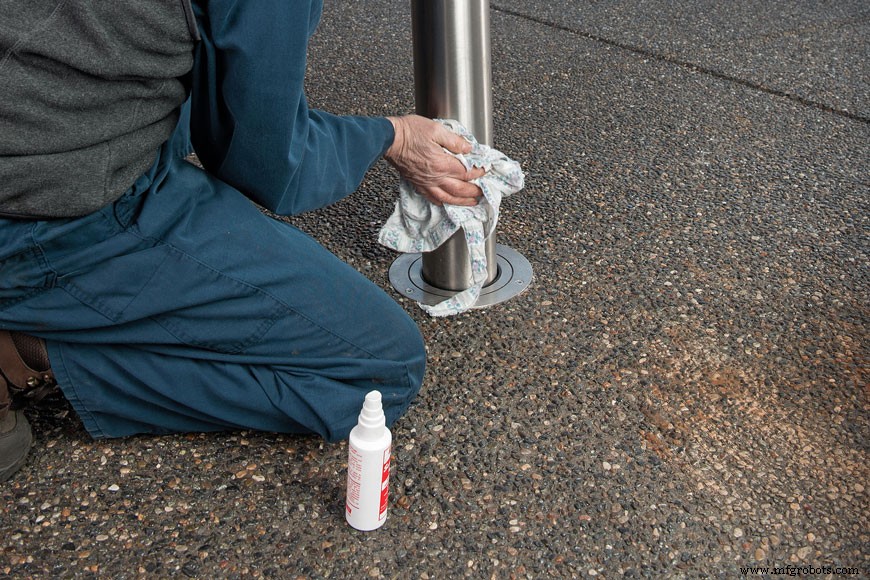
Care and maintenance of stainless steel
Although stainless steel is rust-resistant, it is not impervious. Its corrosion resistance is based on its passivation layer, which can be disturbed chemically. Salts, acids, scratches that hold moisture, and iron deposits can cause stainless steel to become vulnerable to rust.
Care must be taken when installing stainless:steel tools can change the surface chemistry of the steel by leaving behind iron deposits that make the surface vulnerable. Any place that has come into contact with steel should be cleaned. Deep scratches that could hold moisture should be avoided.
Maintenance of stainless surfaces is not difficult but should be undertaken regularly if the steel is exposed to bumps, scratches, salt, iron, or other chemicals. Outdoor site furniture should be attended to twice per year.
The way to clean stainless steel depends on the type of issue at hand. Different strategies are necessary for different types of marks. Our in-depth cleaning post describes steps for discoloration, rust, grease, fingerprints, cement, or limestone. It is good to deal with corrosion quickly. When caught early, WD-40 or another lubricant may be all that is necessary to remove rust.
With proper maintenance and care, the properties of stainless steel that make it so attractive—steel’s toughness wedded to chromium’s corrosion resistance and luster—can continue to be a stress-free asset for years.
For more information on stainless steel, or to request a quote for a custom project, please contact us.
金属


